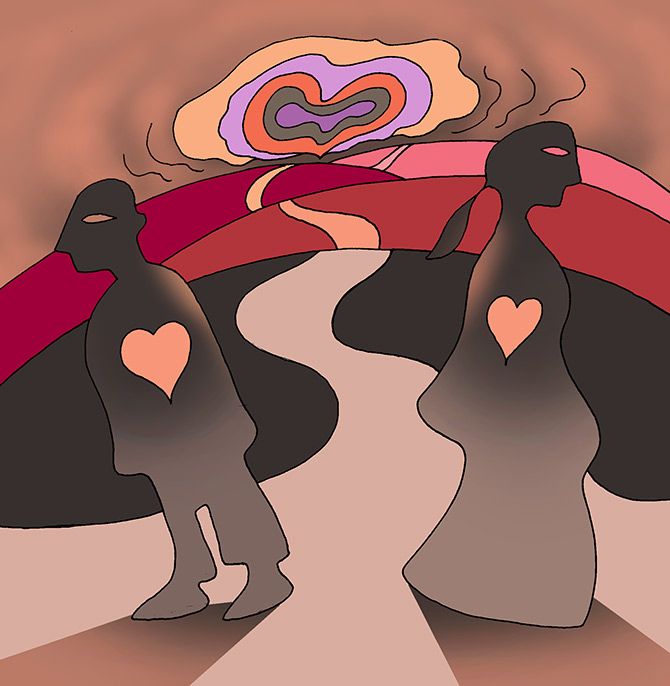Nothing much, says Khushwant Singh.
'To most newly married Indian couples, the concept of privacy is as alien as that of love.'
'They rarely get a room to themselves; the bride-wife sleeps with women members of her husband's family; the husband shares his charpoy lined alongside his father's and brothers'.
'Occasionally the mother-in-law, anxious to acquire a grandson, will contrive a meeting between her son and his wife: The most common technique is to get her to take a tumbler of milk to the lad when other male members are elsewhere.'
Illustrations: Uttam Ghosh/Rediff.com

Many winters ago, I happened to be travelling by a night train from Delhi to Bhopal. It was an express that made a few halts at major stations. I found myself in a compartment of five berths: three below and two on the sides above.
I had a lower berth, as did the other two passengers who were there before me. The upper berths were reserved in the names of a professor and Mrs Saxena.
Fifteen minutes before the train was due to leave, a party of men and women escorting a bride decked in an ornate sari drawn discreetly across her face and her arm loaded with ivory bangles stopped by our compartment, read the names on the panel and came in. They were dismayed to see the two berths reserved for them were separated by a 15-foot chasm of space.
One of the party approached me and asked if I could take one of the upper berths to accommodate the newly married couple. I readily agreed and moved my bedding roll.
Another passenger who had the middle berth also moved up on another upper berth so that the bridal couple could be alongside each other.
I heard one of the party stop the conductor guard and tell him to wake up the pair at a particular junction where the train was to make a brief three-minute halt at 3 am.
As the conductor guard blew his whistle and waved his green flag, the party took leave of the bridal pair, with much embracing and sobbing.
No sooner had the train cleared the lighted platform than the bride blew her nose and uncovered her face. She was a woman in her mid-twenties: Pale-skinned, round-faced and wearing thick glasses.
I couldn't see much of her figure but could guess that she would forever be fighting a losing battle against fat.
Her groom looked to be a couple of years older than her ('professor' being an honorific for a junior lecturer) and, like his bride was sallow-faced, corpulent and bespectacled.
From the snatches of conversation that I could hear (I was only four feet above them) I gathered that they were total strangers and their marriage had been arranged by relatives and through the matrimonial columns of the Hindustan Times.
They talked of their Papajis and Mummyjis. Then of their time in college (the halcyon days for most educated Indians) and of their friends: 'Like a brother to me' or 'better than my own real sister.'
After a while the conversation began to flag. I saw the man's hand resting on his woman's on the window.
The lights were switched off, leaving only a nightlight which bathed the compartment in moonlight blue. I could not see very much except when the train ran past brightly lit platforms of wayside railway stations.
The couple did not bother to use the middle berth vacated for them and decided to make themselves as comfortable as they could on a four-foot-wide wooden plank. They ignored the presence of other passengers in the small compartment and were totally absorbed in getting to know each other.
Such was their impatience that they did not find time to change into more comfortable clothes -- they drew a quilt over themselves and were lost to the world.
The sari is both a very ornamental and a functional dress. Properly draped it can accentuate the contours of the female form, giving a special roundness to the buttocks. A well-cut blouse worn with the sari elevates the bosom, and exposes the belly to below the navel.
There is no other form of female attire which can both conceal the physical shortcomings of the wearer and expose what deserves exposure. A fat woman looks less fat in a sari than she would in a dress and a thin woman looks more filled in.
At the same time a sari is very functional. All a woman has to do when she wants to urinate or defecate is lift it to her waist. When required to engage in quick sexual intercourse, she needs to do no more than draw it up a little and open up her thighs.
Apparently this was what Mrs Saxena was called upon to do. I heard a muffled cry of 'Hai Ram' escape her lips and realised that the marriage had been consummated.
The Saxenas did not get up to go to the bathroom to wash themselves but began a repeat performance. This time they were less impatient and seemed to be getting more out of their efforts.
More than once the quilt slipped off them and I caught a glimpse of the professor's heaving buttocks and his bride's breasts, which he had extricated out of her choli. Above the rattle and whish of the speeding train I heard the girl's whimper and the man's exulting grunts.
They had a third go at each other before peace descended on our compartment.
It was then well past the hour of midnight. Thereafter it was only the wail of the engine tearing through the dark night and the snores of my elderly companions that occasionally disturbed my slumber.
We were rudely disturbed by someone thumping on the door, slapping the window panes and yelling, 'Get up, get up. It is Sehore.The train will leave in another minute.' It was the conductor guard.
I pressed the switch and the compartment was flooded with light. A memorable sight it was!
Professor Saxena fast asleep with his buttocks exposed; Mrs Saxena also fast asleep, her mouth wide, breasts bare, lying supine like a butterfly pinned on a board. Her hair was scattered over her pillow. Their glasses lay on the floor.
Whatever embarrassment they felt was drowned in the hustle and bustle of getting off the train. We heaved out their bedding rolls and suitcases.
The professor stumbled out on the cold platform adjusting his fly. She followed him, covering her bared bosom with a flap of her sari.
As the train began to move, she screamed: One of her earrings was missing. The friendly guard brought the train to a halt. All of us went down on our knees scouring the floor. The errant earring was found wedged in a crevice of the seat. We resumed our journey.
'It is love,' remarked one of my travelling companions with great understanding. 'They are newly married and this was their first night together. All should be forgiven to people in love.'
'What kind of love?' I asked in a sarcastic tone. 'A few hours ago they were complete strangers. They haven't the patience to wait till they get home and start having sex without as much as exchanging a word of affection. You call that love?'
'Well,' he replied pondering over the episode. 'They may not get another chance for some days. There will be his relatives, his mother, sisters, brothers. And lots of religious ceremonies. Youth is impatient and the body has its own compulsions. Let us say it is the beginning of love.'
'It may be the beginning of another family, but I don't see where love comes in,' I remarked. 'I can understand illiterate peasants coupling like the cattle they rear, but I cannot understand two educated people, a lecturer in a college and a schoolteacher, so totally lacking in sophistication or sense of privacy as to begin copulating in the presence of three strangers.'
'You have foreign ideas,' said the third man, dismissing me. 'Anyway, it is three-thirty in the morning. Let's get some sleep.'
He switched off the light and the argument.

The episode stayed in my mind because it vividly illustrated the pattern of the man-woman relationship that obtains among the vast majority of Indians.
Love, as the word is understood in the West, is known only to a tiny minority of the very Westernised living in the half a dozen big cities of India who prefer to speak English rather than Indian languages, read only English books, see only Western movies and even dream in English. For the rest, it is something they read about in poems or see on the screen but very rarely experience personally.
Arranged marriages are the accepted norm, 'love' marriages a rarity.
In arranged marriages, the parties first make each other's acquaintance physically through the naked exploration of each other's bodies and it is only after some of the lust has been drained out of their systems that they get the chance to discover each other's minds and personalities.
It is only after lust begins to lose its potency and there is no clash of temperaments that the alliance may in later years develop bonds of companionship. But the chances of this happening are bleak. In most cases, they suffer each other till the end of their days.
I have no idea what became of the Saxenas whose nuptial consummation I had witnessed. It is likely that they produced a small brood of Saxenas.
He is probably a full professor teaching romantic poetry and occasionally penning a verse or two to some younger lady professor ('like a sister to me') or to some pigtailed student ('like my own daughter').
Mrs Saxena probably tries to retain her husband's interest by dog-like devotion, prayer and charms brought from 'holy' men.
On the rare occasions when the professor mounts her, she has to fantasise about one of his younger colleagues ('exactly like a real brother to me') before she shudders in the throes of an orgasm with the name of God on her lips: 'Hai Ram'.
The Saxenas are luckier than most Indian couples because they live away from their families and are assured a certain amount of privacy.
To most newly married Indian couples, the concept of privacy is as alien as that of love. They rarely get a room to themselves; the bride-wife sleeps with women members of her husband's family; the husband shares his charpoy lined alongside his father's and brothers'.
Occasionally the mother-in-law, anxious to acquire a grandson, will contrive a meeting between her son and his wife: The most common technique is to get her to take a tumbler of milk to the lad when other male members are elsewhere.
The lad grabs the chance for the 'quickie'.
Hardly ever do the couple get enough time for a prolonged and satisfying bout of intercourse.
Most Indian men are not even aware that women also have orgasms; most Indian women share this ignorance because although they go from one pregnancy to another they have no idea that sex can be pleasurable.
This is a sad commentary on the people of a country which produced the most widely read treatise on the art of sex, the Kama Sutra, and elevated the act of sex to spiritual sublimity by explicit depictions on its temples.
Excerpted with the kind permission of Juggernaut Books from We Indians by Khushwant Singh, available on the Juggernaut app and in bookstores.
~ You can buy Khushwant Singh's books here.









